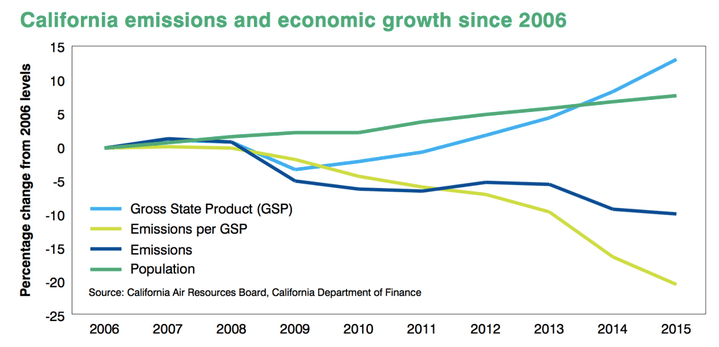At the United Nations’ Framework Convention on Climate Change meeting in Germany this week, California Governor Jerry Brown has been designated Special Advisor for States and Regions, and will be working with state and international partners on ways to meet the commitments of the Paris Agreement on climate change. While California is not the only place that has created a cap-and-trade system to help reduce greenhouse gas emissions, it has gained considerable experience since the state legislature passed the Global Warming Solutions Act in 2006.
To help focus the conversation, the Environmental Defense Fund has prepared a quick fact sheet on cap-and-trade. It explains how California created its system, listing ten steps on a timeline towards designing, operating, and refining a market-based system that uses industry's self-interest to help reduce global greenhouse gas emissions.
The fact sheet is timely, because the convention will include discussions about broadening the scope of systems like cap-and-trade beyond a single state or nation. California already coordinates its cap-and-trade system with Ontario, and is working with other nations and states, but to truly make a difference the system needs to have a much broader reach.
California's results have been strong. Statewide greenhouse gas emissions have declined since 2006, and the carbon intensity of the state economy has also decreased, according to the fact sheet.
At the same time, California's economy has grown, with job growth outpacing that of the rest of the country (6.2 percent growth, compared to 4.8 percent for the U.S. as a whole), and so-called “green jobs” especially high (23.3 percent more green jobs between 2013 and 2015). Says the EDF:
California’s cap-and-trade program is directly benefiting residents through climate investments from auction revenues, new clean energy jobs, and local air quality initiatives.
EDF's fact sheet could be useful for explaining the benefits of cap-and-trade to your relatives at Thanksgiving. It focuses on the economic benefits California has reaped, in part because it is a strong counter argument to charges that cap-and-trade will wreak havoc with the economy.
But because the fact sheet is so short, it also risks underemphasizing a few very key points. The use of offsets, for example, has to be very carefully considered, not just "considered" as Step 4 has it:
In California, offset credits must be real, additional, permanent, verifiable, quantifiable, enforceable and produced based on a CARB-approved protocol.
Offsets are not just an economic question, but one that directly affects local residents. Charges from some advocates that being able to pay for offsets elsewhere have led to companies emitting more pollution locally have sometimes been lost in the focus on economic gain.
It would also be worth pointing out how crucial “Step 8” of the fact sheet is: “Engage stakeholders, communicate and build capacities.” California is investing in several programs that ostensibly are about reducing greenhouse gas emissions but also create opportunities for people to be involved in the discussion around shaping cap-and-trade. An example is the Affordable Housing and Sustainable Communities program, the purpose of which is to connect sustainable transportation choices and housing, thus helping reduce greenhouse gas emissions--but which also offers real money to create real change.
California's cap-and-trade investments are the result of robust discussions about what constitutes a fair system to reduce emissions while ensuring opportunities for all residents. Those investments must also avoid making things worse for communities that already pay a high price in pollution exposure and health and other risks from climate change.
New cap-and-trade programs should pay as much attention to equity as they do to economic benefits, to avoid skewing results in favor of polluting industry and away from residents who live with that pollution.






